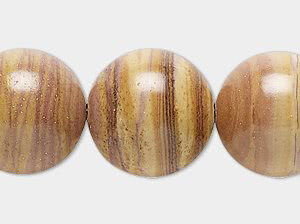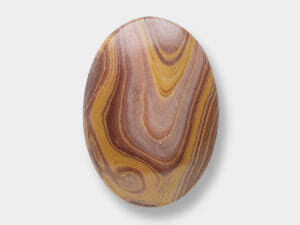Autumn Hickoryite Meaning and Properties
Autumn Hickoryite History
Autumn hickoryite, also known as rainbow hickoryite, is a commercial name for a variety of rhyolite . It is mostly tans and browns with radial banding of reddish-brown, pink and yellow tones. In addition to beads, autumn hickoryite has been used for arrowheads, lapidary roughs, cabochons and more.
What are the Metaphysical Properties of Autumn Hickoryite?
According to metaphysical beliefs, autumn hickoryite meaning includes stimulating imaginative thinking and a desire for adventure. It is thought to promote stylishness and originality, especially those in the creative arts or people who simply need inspiration for innovative thinking. As a form of rhyolite, autumn hickoryite meaning also has strong associations with the Earth. Although not a birthstone, it is a zodiac stone of Gemini, Sagittarius and Aquarius.
What is Autumn Hickoryite Made From?
Autumn hickoryite is a variety of rhyolite, an extrusive igneous rock with fine-grained crystals that include quartz, mica and feldspar, with a similar chemical composition to granite. One notable difference: autumn hickoryite, with a hardness of 3-1/2, is not as hard as rhyolite at 6 to 6-1/2 on the Mohs scale. A rare gemstone, major deposits of autumn hickoryite have been found near Rodeo, State of Durango, in Mexico.
- Mineral Information: Rhyolite is an extrusive rock that has fine-grained crystals. The crystals can include quartz, feldspar and mica, making the stone similar to granite.
- Chemical Composition: SiO₂ + K₂O (70-75% silicon dioxide + Potassium Oxide) Note: Hickoryite is a rock, not a single mineral. As such, it does not have a single chemical formula like a mineral would. Rocks are made up of multiple minerals, each with its own chemical formula.
- Color: Reddish-brown, pink and yellow tones
- Hardness: Rhyolite is known for having a Mohs hardness rating of 6 – 6-1/2 on the Mohs scale. In comparison, hickoryite only has a rating of 3-1/2.
- Specific Gravity: 2.70
- Refractive Index: 1.486 – 1.658
How Do You Clean Autumn Hickoryite?
Clean autumn hickoryite jewelry with a soft dry cloth. Wash with warm, soapy water and a soft cloth or soft brush. Dry thoroughly. Avoid using harsh cleaning products that can include bleach and acid. Do not use ultrasonic cleaners or steamers.
Autumn Hickoryite FAQ
Q: Is it true that autumn hickoryite is only found in the United States?
A: Autumn hickoryite does come from a single American location, but it is not in the United States, but rather in the State of Durango, Mexico.
Q: What colors and patterns are most common in autumn hickoryite?
A: Autumn hickoryite is a banded stone that includes shades of brown, yellow and pink in a pattern similar to woodgrain.
Q: Do designers use autumn hickoryite for designs that are only autumn themed?
A: Because of its similarity to woodgrain, autumn hickoryite can be used in a wide variety of jewelry designs, including boho and organic themes. Its subtle brown colors also lend themselves well to jewelry inspired by the desert or the beach, as they mimic the soft shades of sand.
Q: Does copper pair well with autumn hickoryite?
A: The warm tones of copper beautifully complement the tan shades in autumn hickoryite. For greater contrast, other colors of metal can be used as well.
Q: How does autumn hickoryite compare to other patterned stones like picture jasper or moukaite jasper?
A: There are many beautiful brown-hued patterned gemstones. The following is a summary of their qualities:
Autumn Hickoryite:
- Mohs hardness of 3-1/2
- Color: Sandy browns with pink and yellow striations
- Look: Smooth striations similar to fine woodgrain
Bronze Zebra Jasper:
- Mohs hardness of 6-1/2 to 7
- Color: Whites, tans, browns
- Look: Stripes are broader and more irregular than the striations in autumn hickory jasper
Brown Chrysanthemum Stone:
- Mohs hardness of 3 to 4
- Color: Mahogany, browns, gold
- Look: Intricate veining in irregular patterns
Limestone (Landscape Stone):
- Mohs hardness: 2 to 4
- Color: Cream, honey and dark brown
- Look: Patterns are dramatic both in shape and color mix, forming miniscule landscapes on every specimen
Moukaite Jasper
- Mohs hardness: 6-1/2 to 7
- Color: Broad range of earth tones, from cream and gold to brown, brick red and mauve
- Look: Patterns are marbled instead of striated
- Mohs hardness: 6-1/2 to 7
- Color: Golden, sandy and darker browns, cream
- Look: Patterns do have striations, like autumn hickoryite, but picture jasper has speckles throughout, which is characteristic of all jasper.
Tiger Iron
- Mohs hardness: 5 to 7
- Color: Gold, brick red, dark browns, dark greys
- Look: Striations smooth and linear, but colors are darker and richer than those in autumn hickoryite or picture jasper
Tigereye
- Mohs hardness: 7
- Color: Gold or yellow with brown, chatoyant luster
- Look: Striations are very smooth, mimicking the look of silk or water, rather than woodgrain.
Designing with Autumn Hickoryite
Because of its bands of brown and tan colors, autumn hickoryite—as the name implies—works well with autumn-themed designs. It lends itself as an integral component for designs based around beaches or deserts, especially those of the southwestern United States. Autumn hickoryite is also a natural choice for Native American-inspired designs and a range of Boho styles.
Shop for Autumn Hickoryite
**Please note that all metaphysical or healing properties listed are collected from various sources. This information is offered as a service and not meant to treat medical conditions. Fire Mountain Gems and Beads® does not guarantee the validity of any of these statements.
How did you like this resource? Your feedback helps us provide resources that matter to you most.
Copyright Permissions
All works of authorship (articles, videos, tutorials and other creative works) are from the Fire Mountain Gems and Beads® Collection, and permission to copy is granted for non-commercial educational purposes only. All other reproduction requires written permission. For more information, please email copyrightpermission@firemtn.com.


